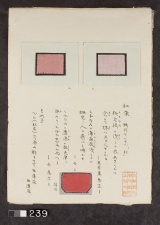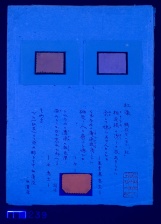Difference between revisions of "Benibana (Safflower) - right (239 R)"
Jump to navigation
Jump to search
(username removed) |
m (MDerrick moved page Benibana - right (239 R) to Benibana (Safflower) - right (239 R) without leaving a redirect) |
||
| (2 intermediate revisions by one other user not shown) | |||
| Line 5: | Line 5: | ||
| 239 | | 239 | ||
|- | |- | ||
| − | ! scope="row"| | + | ! scope="row"|Uemura number / title |
| − | | | + | | ; "Haze-some 25" |
|- | |- | ||
! scope="row"|Folder location | ! scope="row"|Folder location | ||
| Line 44: | Line 44: | ||
| vinegar (separate bath) | | vinegar (separate bath) | ||
|- | |- | ||
| − | ! scope="row"| | + | ! scope="row"|Uemura's notes |
| − | | This color is what was called "Beni ( | + | | This color is what was called "Beni ()" in the Buyakuryo (), the 8th century AD, Japan. The plant was also read in Japanese classic poems in the Manysh () from the 7th -8th century AD: (volume 12); (volume 12); and (volume 11). |
|- | |- | ||
| − | ! scope="row"| | + | ! scope="row"|Uemura's date |
| Kyoto Murasakino | | Kyoto Murasakino | ||
|} | |} | ||
| − | [[Category: | + | [[Category:Uemura dye archive]] |
Latest revision as of 11:26, 22 June 2020
| Museum number | 239 |
|---|---|
| Uemura number / title | ; "Haze-some 25" |
| Folder location | 4th shelf |
| Sample location | right (239 R) |
| Fiber type | cotton |
| Color | light pink |
| Dyestuff (Japanese common name) | 紅花 : Benibana |
| Dye (English common name) | Safflower |
| Dyestuff (botanical name) | Carthamus tinctoris L. |
| Plant part | flower petal / dried |
| Dyestuff extraction | boiled in water (?) |
| Auxiliary agent in dye bath | - |
| Mordant | - |
| Other auxiliary agent | vinegar (separate bath) |
| Uemura's notes | This color is what was called "Beni ()" in the Buyakuryo (), the 8th century AD, Japan. The plant was also read in Japanese classic poems in the Manysh () from the 7th -8th century AD: (volume 12); (volume 12); and (volume 11). |
| Uemura's date | Kyoto Murasakino |

